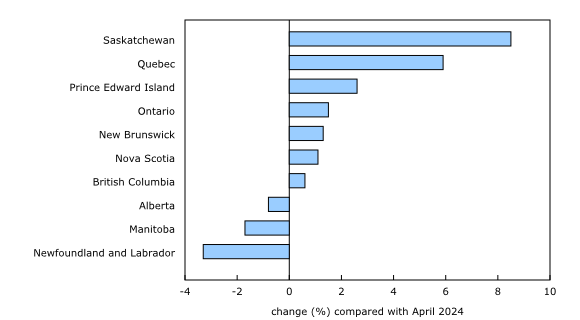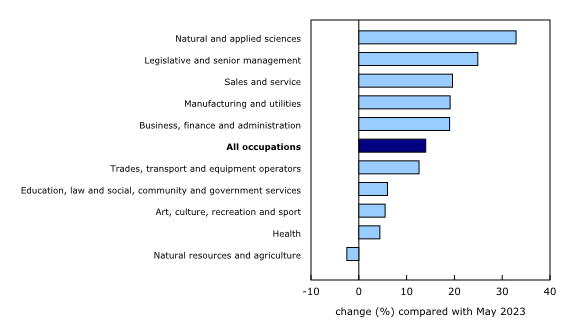Employment Insurance, May 2024
Released: 2024-07-18
In May, 464,000 Canadians received regular Employment Insurance (EI) benefits, up 1.9% (+8,700) from April. Prior to the increase in May, the number of regular EI recipients had held relatively steady since September 2023.
On a year-over-year basis, the number of regular EI beneficiaries was up by 57,000 (+14.0%) in May 2024.
Data from the Labour Force Survey show that employment was little changed in May and the unemployment rate rose 0.1 percentage points to 6.2%. Compared with 12 months earlier, the unemployment rate was up by 0.9 percentage points in May.
In general, variations in the number of EI beneficiaries can reflect changes in the circumstances of different groups, including those becoming beneficiaries, those going back to work, those exhausting their regular benefits, and those no longer receiving benefits for other reasons.
More men receive regular Employment Insurance benefits in May
The number of regular EI beneficiaries among young men (15 to 24 years old) rose by 5.3% (+1,600) in May, partly offsetting a decrease of 2,200 in April. Men aged 55 and older (+3,400; +4.6%) as well as core-aged men (25 to 54 years old) (+3,100; +1.8%) also posted increases in the month. For men aged 55 and older, the increase partly offset a decrease in April, while for core-aged men, the increase in May followed three consecutive monthly declines.
The number of regular EI beneficiaries among young women declined 2.5% (-300) in May, while it increased 1.4% (+700) among women aged 55 and older and was little changed among core-aged women.
On a year-over-year basis, there were more regular EI beneficiaries among all major demographic groups, led by core-aged men (+18.3%; +27,000) and core-aged women (+12.4%; +13,000).
More regular Employment Insurance recipients in six provinces in May
The number of regular EI beneficiaries rose in six provinces in May. Saskatchewan (+8.5%; +1,100) posted the largest proportional increase, followed by Quebec (+5.9%; +6,100). The increase in Saskatchewan partly offset a decline of regular EI recipients in April (-10.7%; -1,600), while the additional recipients in Quebec marked the third increase in four months.
In Saskatchewan, the province's two census metropolitan areas (CMAs) accounted for over one-third (37.3%) of the 1,100 increase in the number of regular EI recipients in the province, with the number of recipients in Saskatoon up 10.5% (+300) and the number in Regina up 6.0% (+100) in May.
In Quebec, the Montréal CMA saw the number of regular EI beneficiaries increase by 8.4% (+3,500) in May compared with April, and accounted for over half (57.9%) of the provincial increase (+6,100) in the number of regular EI recipients in May.
There were also more EI recipients in Prince Edward Island (+2.6%; +200), Ontario (+1.5%; +2,100), New Brunswick (+1.3%; +300) and Nova Scotia (+1.1%; +200) in May. Newfoundland and Labrador posted a third consecutive monthly decline in May, as the number of recipients decreased 3.3% (-900) in the month. The number of EI recipients in Manitoba (-1.7%; -300) was also down in May, the second consecutive monthly decline. Alberta and British Columbia posted little change in the month.
The number of regular Employment Insurance beneficiaries up in most major occupational groups
On a year-over-year basis, the number of regular EI beneficiaries was up in all broad occupational categories in May, except in natural resources, agriculture and related production occupations.
The largest proportional increase was among regular EI recipients who last worked in natural and applied sciences and related occupations (+32.9%; +8,200). Over the same period, there was also a notable increase in the number of regular EI beneficiaries who last worked in sales and service occupations (+19.6%; +13,000), including as sales and service representatives and other customer and personal services occupations (+21.4%; +4,000) and sales and service support occupations (+14.8%; +3,300).
In May 2024, 34.2% of regular EI beneficiaries had last worked in trades, transport and equipment operators and related occupations, the highest proportion among the major occupational categories. This was followed by sales and service occupations (16.6%) and business, finance and administration occupations (12.0%).
Did you know we have a mobile app?
Download our mobile app and get timely access to data at your fingertips! The StatsCAN app is available for free on the App Store and on Google Play.
Sustainable Development Goals
On January 1, 2016, the world officially began implementing the 2030 Agenda for Sustainable Development—the United Nations' transformative plan of action that addresses urgent global challenges over the following 15 years. The plan is based on 17 specific sustainable development goals.
Employment Insurance statistics are an example of how Statistics Canada supports reporting on global sustainable development goals. This release will be used to help measure the following goal:

Note to readers
Revisions to Employment Insurance statistics
With the July 18, 2024, release of May data, the seasonally adjusted series of Employment Insurance statistics have been revised back to January 2000 to reflect the most recent seasonal factors as well as the 2021 Standard Geographical Classification (SGC). Also, data for Employment Insurance (EI) beneficiaries by occupation conforming to the 2021 National Occupational Classification are available from January 2008 onwards.
Concepts and methodology
EI statistics are produced from administrative data sources provided by Service Canada and Employment and Social Development Canada. These statistics may, from time to time, be affected by changes to the Employment Insurance Act or administrative procedures.
EI statistics indicate the number of people who received EI benefits and should not be confused with Labour Force Survey (LFS) data, which provide estimates of the total number of unemployed people. There is always a certain proportion of unemployed people who do not qualify for benefits. Some unemployed people have not contributed to the program because they have not worked in the past 12 months or their employment was not insured. Other unemployed people have contributed to the program, but do not meet the eligibility criteria, such as workers who left their jobs voluntarily or those who did not accumulate enough hours of work to receive benefits.
All data in this release are seasonally adjusted, unless otherwise specified. To model the effects of the COVID-19 pandemic, values for all series from March 2020 to December 2022 have been treated with a combination of level shifts and outliers to determine a seasonal pattern for seasonal adjustment. For more information on seasonal adjustment, see Seasonally adjusted data – Frequently asked questions.
The number of regular EI beneficiaries for the current month and the previous month is subject to revision.
The number of beneficiaries is all people who received regular EI benefits from May 12 to 18, 2024. This period coincides with the reference week of the LFS.
A census metropolitan area (CMA) and a census agglomeration (CA) are formed by one or more adjacent municipalities centred on a population centre. A CMA must have a total population of at least 100,000. A CA must have a population of at least 10,000. See Standard Geographical Classification (SGC) 2021 for more information.
Next release
Data on EI for June will be released on August 22.
Products
More information about the concepts and use of Employment Insurance statistics is available in the Guide to Employment Insurance Statistics (73-506-G).
Contact information
For more information, or to enquire about the concepts, methods or data quality of this release, contact us (toll-free 1-800-263-1136; 514-283-8300; infostats@statcan.gc.ca) or Media Relations (statcan.mediahotline-ligneinfomedias.statcan@statcan.gc.ca).
- Date modified:





